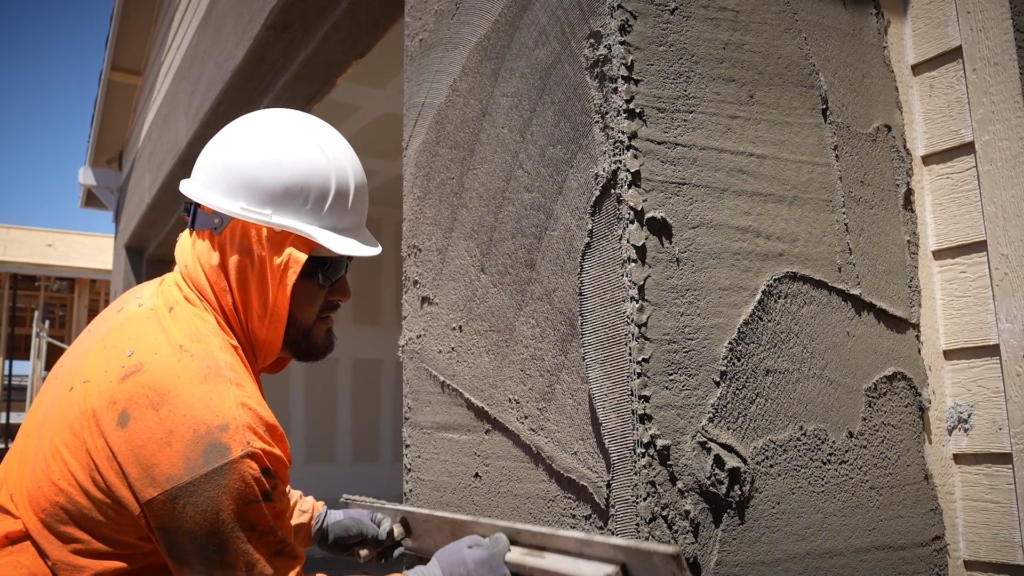If you live in the Southwest, you’ve likely noticed that most homes feature stucco exteriors. Stucco is a popular choice for desert climates because it’s durable, energy-efficient, and aesthetically appealing. However, it’s also common for homeowners to notice small cracks appearing over time. If you’ve seen these hairline cracks on your home, don’t worry—they’re completely normal.
✅ What is Stucco?
Stucco is made from a mix of sand, cement, lime, and water, and sometimes includes extra materials like fibers or acrylics for added strength. When it’s applied correctly and maintained with paint and minor repairs, it can hold up well against Arizona’s intense sun and dry climate.
It’s important to know that stucco isn’t what a house is built from—it’s a protective outer layer. After the home’s wood framing and sheathing are complete, a vapor barrier is added, followed by foam insulation. Then, a metal mesh is placed over the surface, and two layers of stucco are applied by hand to finish the exterior.
✅ Why Does Stucco Crack?
Stucco is a cement-based material, and like all cement products, it can develop tiny cracks as it cures and as your home naturally expands and contracts with temperature changes. This is especially true in the Southwest, where extreme temperature swings and dry conditions are part of daily life. Some cracking is always to be expected. This can be most commonly seen radiating from the corners of windows and doors.
✅ Are Hairline Cracks a Problem?
No. Hairline cracks in stucco are cosmetic, not structural, and they do not indicate water intrusion. Stucco is a porous material, so the surface may show cracks without affecting your home’s integrity or allowing leaks.
According to the Arizona Registrar of Contractors (ROC), cracks less than 1/16″ wide meet the state’s minimum workmanship standards and do not require repair. To put that in perspective, 1/16″ is about the thickness of two credit cards or a U.S. penny.
✅ Why We Don’t Recommend Patching Every Crack
While it may seem logical to repair every small crack, doing so can actually make things look worse. Spot-patching stucco and repainting those spots often creates visible color variations called “tiger striping”, which detracts from your home’s curb appeal more than the original hairline cracks.
✅ Why Every Crack Cannot Be Repaired
Only cracks of substantial width can be filled and patched. Hairline cracks are too skinny to even apply any type of patch material inside of them.
✅ What Can Improve the Look of Stucco Cracks?
Routine painting by a professional can drastically reduce the amount of hairline stucco cracks visible. We recommend a professional because that painter will understand the way paint needs to be applied to cover stucco cracks properly. Additionally, all cement based products contain a high pH content which can be detrimental to certain paints or paint applications.
✅ What About Water Intrusion?
Typically, there will be no signs of water intrusion associated with normal hairline cracking. Modern stucco systems are designed to drain and protect your home, and these tiny surface cracks in an already porous material do not compromise that system. Additionally, a water-resistive barrier sits below the stucco surface further protecting your home from water intrusion.
✅ What Homeowners Can Do
-
Inspect annually: Keep an eye on your exterior and note any significant changes.
-
Contact us if cracks widen: If you see cracks larger than 1/16″ or notice other issues, let us know—we’re here to help.
-
Maintain your stucco: Repainting your home every 7–10 years can help maintain its fresh appearance.
Final Thoughts
Hairline stucco cracks are part of owning a home in the Southwest and are considered normal and cosmetic. Your home is safe, secure, and built to last—even with a few tiny stucco cracks.
If you are a Scott Communities customer and have more questions about your home’s stucco, please reach out to our customer care department and we will provide guidance.



